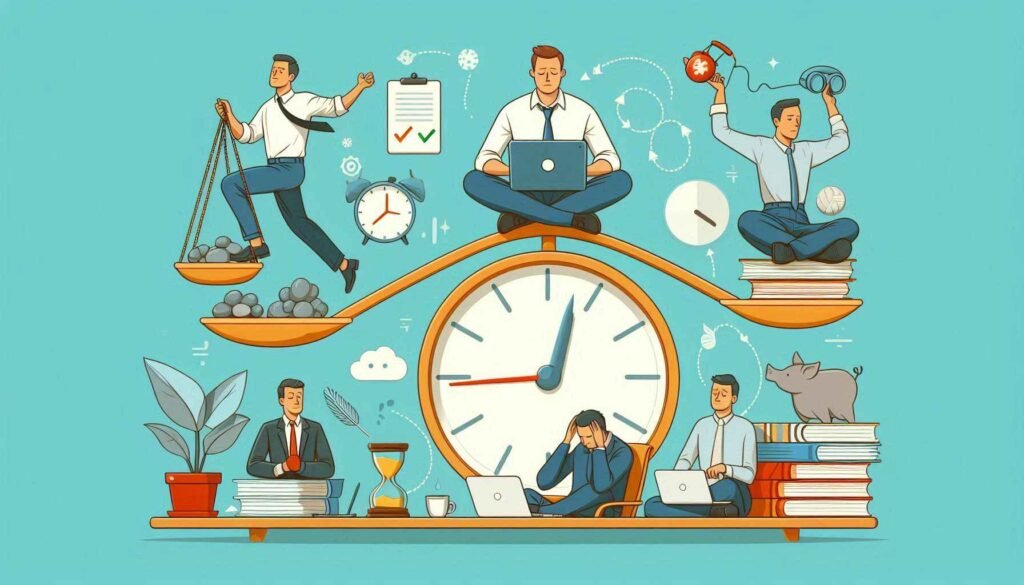
Work-Life Balance: Strategies for Managing Stress and Burnout
Achieving a work-life balance is more crucial than ever. Many of us feel overwhelmed by work demands, leaving little time for personal well-being. This imbalance can lead to chronic stress and burnout, impacting our physical and mental health. But it doesn’t have to be this way. Here’s how to develop practical strategies to manage stress and prevent burnout.
The Importance of Work-Life Balance
Work-life balance isn’t about dividing your day into equal work and personal time. It’s about finding a sustainable way to meet the demands of your job while prioritizing your personal life. When achieved, it can enhance your happiness, health, and productivity. Studies show that employees with good work-life balance report lower stress levels and are more satisfied in their jobs. If you constantly feel exhausted, overwhelmed, or disconnected from loved ones, it’s time to reassess and make adjustments.
Signs You May Be Struggling With Balance
If you’re wondering whether you’re striking the right balance, here are a few indicators that may suggest otherwise:
- Chronic Fatigue: When even simple tasks feel monumental.
- Relationship Strain: Struggling to connect with friends or family.
- Health Problems: Experiencing frequent headaches, digestive issues, or poor sleep.
- Work Preoccupation: Thinking about work constantly, even when you’re not working.
Common Causes of Burnout and Stress
Burnout doesn’t happen overnight. It results from a prolonged state of stress. Understanding the causes is the first step in addressing it.
1. Unmanageable Workloads
Long working hours and overwhelming tasks contribute to high levels of stress. When you feel like you’re constantly catching up, it’s easy to get stuck in a cycle of burnout.
2. Lack of Control
Feeling powerless over your schedule or work environment can add to stress. If you’re unable to control the demands placed on you, it can significantly impact your mental health.
3. Neglecting Personal Needs
Sacrificing hobbies, social life, or relaxation time for work leads to dissatisfaction. Your well-being is crucial to productivity, so neglecting personal needs creates an unhealthy pattern.
4. The Busyness Trap
Many people wear “busyness” as a badge of honor, equating it with success. However, being constantly busy without purpose drains energy and doesn’t necessarily equate to productivity.
Strategies for Achieving Work-Life Balance
Now that we understand the challenges, let’s look at strategies to achieve a healthier balance.
1. Set Clear Boundaries
Define when your workday ends and commit to sticking to it. Avoid checking emails or taking calls outside work hours. Let your team know about your availability and be firm about off-limits time. These boundaries help separate your work from your personal life, allowing time to recharge.
2. Time Management Techniques
Effective time management is key to reducing stress:
- Prioritize Tasks: Focus on high-impact tasks first and eliminate unnecessary distractions.
- Use Time Blocks: Dedicate specific hours to different activities, such as work tasks, exercise, or family time.
- Practice the Pomodoro Technique: Work in 25-minute bursts with five-minute breaks. This approach prevents fatigue while maintaining productivity.
3. Learn to Say No
Often, we take on more than we can handle due to the fear of missing out or disappointing others. Learning to say “no” can be empowering. When approached with additional tasks or commitments, give yourself time to decide instead of agreeing immediately. Reflect on whether the task aligns with your priorities.
4. Incorporate Mindfulness and Meditation
Mindfulness practices help reduce stress by grounding you in the present moment. Set aside 10-15 minutes daily for meditation or breathing exercises. Techniques like deep breathing, body scans, or guided visualizations can significantly reduce anxiety and enhance focus.
5. Delegate and Share Responsibilities
Don’t hesitate to delegate tasks when possible. At work, share responsibilities with colleagues, and at home, involve family members in daily chores. Delegating not only lightens your load but also fosters teamwork.
6. Take Advantage of Work-Life Benefits
If your employer offers flexible schedules, remote work, or wellness programs, utilize them. Such benefits are there to support a healthy balance. Discuss your needs with your supervisor to see if accommodations can be made for a more manageable workload.
Self-Care Practices to Combat Burnout
Practicing self-care isn’t a luxury; it’s a necessity for maintaining health and productivity.
1. Stay Active
Regular physical activity boosts mood and energy. It doesn’t have to be intense. Even a 20-minute walk can improve your well-being. Consider integrating stretching, yoga, or light exercises during breaks to stay active throughout the day.
2. Nourish Your Body
Eating a balanced diet supports physical and mental health. Avoid skipping meals or opting for processed foods, as these habits can exacerbate fatigue and mood swings. Focus on nutrient-dense foods that provide lasting energy.
3. Prioritize Sleep
Getting quality sleep is crucial for recovery. Aim for 7-9 hours per night and establish a bedtime routine that includes winding down activities, like reading or meditating. Avoid screens an hour before bed to improve sleep quality.
4. Engage in Mindful Practices
Simple activities like journaling, gratitude exercises, or a “five senses reset” can help clear your mind. For a five senses reset, keep items at your desk that engage different senses—such as a scented candle or a stress ball—and use them to take a quick mental break.
How Employers Can Support Work-Life Balance
Employers play a crucial role in helping employees achieve a healthy balance. Here’s how they can help:
- Flexible Work Arrangements: Offering remote work or hybrid schedules allows employees to manage their time better.
- Encourage Breaks and Time Off: Promote the use of vacation days and mental health breaks.
- Employee Assistance Programs (EAPs): Provide resources such as counseling services or wellness programs to support mental health.
Real-Life Examples of Effective Work-Life Balance
Let’s look at some strategies used by companies recognized for their employee-centric policies:
- Tech Companies and Remote Work: Many tech firms offer flexible work hours and wellness stipends, allowing employees to work from anywhere while still achieving productivity goals.
- Healthcare Firms’ Wellness Initiatives: Several healthcare providers have implemented on-site fitness centers and mental health resources, recognizing the importance of employees’ holistic well-being.
Tips for Sustaining Work-Life Balance Long-Term
Finding a balance is a continuous journey rather than a one-time fix. Here are ways to maintain it:
- Reassess Regularly: Periodically evaluate your routine and make adjustments based on your life changes.
- Stay Flexible: Life is dynamic, and sometimes the balance may shift. Allow yourself to adapt to new circumstances.
- Focus on Quality Over Quantity: Instead of trying to cram more into your day, aim for meaningful engagement in the activities you choose.
Conclusion
Achieving work-life balance is possible with intentional changes to your daily habits and mindset. The strategies discussed—setting boundaries, prioritizing self-care, and utilizing employer resources—can significantly improve your well-being. Remember, balance looks different for everyone. It’s not about perfection but finding a rhythm that works for you. Take proactive steps today to manage stress and prevent burnout, and you’ll create a more fulfilling and healthier life.



